Analysis of AUT Post-Graduate Student Environment Perceptions
VerifiedAdded on 2020/05/11
|68
|17949
|68
Report
AI Summary
This report presents a qualitative analysis of the changing perceptions of students regarding the environment at Auckland University of Technology (AUT) during their post-graduate experience. The study, conducted through interviews with Master's program students, employs a post-positivist research paradigm and a qualitative descriptive method to comprehensively summarize specific events and experiences. The research utilizes a semi-structured questionnaire and the NVIVO software for data analysis, focusing on thematic nodes such as motivation, teaching style, infrastructure, and challenges faced by international students. Findings reveal that students perceive AUT positively, citing modern facilities, supportive faculty, and a dynamic campus environment, while also highlighting infrastructure-related challenges and offering recommendations for improvement. The report provides a comparative overview of experiences, emphasizing the contrast between AUT and students' previous educational institutions. The research concludes by discussing the skills developed and challenges encountered throughout the study, offering valuable insights into the experiences of post-graduate students at AUT.
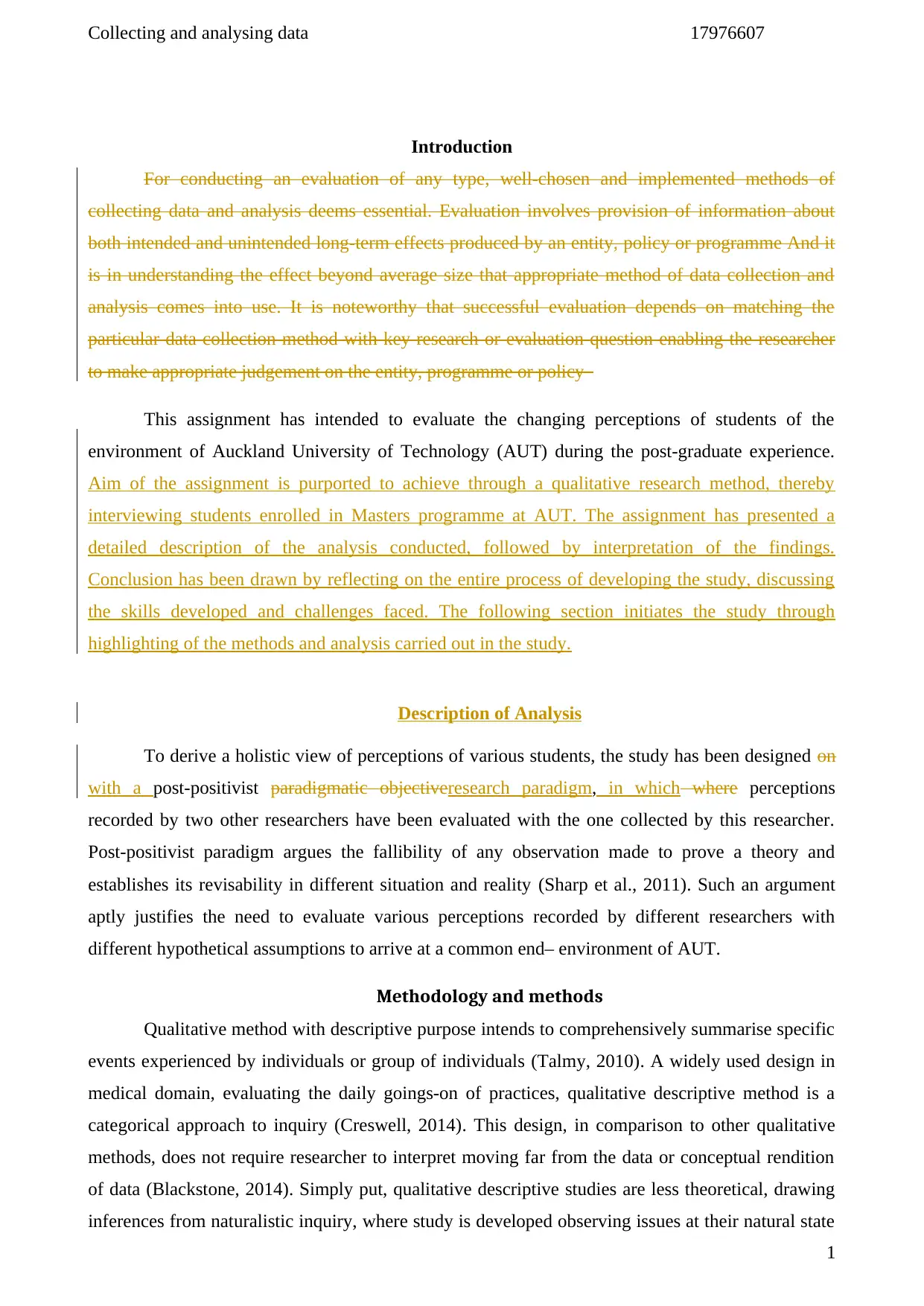
Collecting and analysing data 17976607
Introduction
For conducting an evaluation of any type, well-chosen and implemented methods of
collecting data and analysis deems essential. Evaluation involves provision of information about
both intended and unintended long-term effects produced by an entity, policy or programme And it
is in understanding the effect beyond average size that appropriate method of data collection and
analysis comes into use. It is noteworthy that successful evaluation depends on matching the
particular data collection method with key research or evaluation question enabling the researcher
to make appropriate judgement on the entity, programme or policy
This assignment has intended to evaluate the changing perceptions of students of the
environment of Auckland University of Technology (AUT) during the post-graduate experience.
Aim of the assignment is purported to achieve through a qualitative research method, thereby
interviewing students enrolled in Masters programme at AUT. The assignment has presented a
detailed description of the analysis conducted, followed by interpretation of the findings.
Conclusion has been drawn by reflecting on the entire process of developing the study, discussing
the skills developed and challenges faced. The following section initiates the study through
highlighting of the methods and analysis carried out in the study.
Description of Analysis
To derive a holistic view of perceptions of various students, the study has been designed on
with a post-positivist paradigmatic objectiveresearch paradigm, in which where perceptions
recorded by two other researchers have been evaluated with the one collected by this researcher.
Post-positivist paradigm argues the fallibility of any observation made to prove a theory and
establishes its revisability in different situation and reality (Sharp et al., 2011). Such an argument
aptly justifies the need to evaluate various perceptions recorded by different researchers with
different hypothetical assumptions to arrive at a common end– environment of AUT.
Methodology and methods
Qualitative method with descriptive purpose intends to comprehensively summarise specific
events experienced by individuals or group of individuals (Talmy, 2010). A widely used design in
medical domain, evaluating the daily goings-on of practices, qualitative descriptive method is a
categorical approach to inquiry (Creswell, 2014). This design, in comparison to other qualitative
methods, does not require researcher to interpret moving far from the data or conceptual rendition
of data (Blackstone, 2014). Simply put, qualitative descriptive studies are less theoretical, drawing
inferences from naturalistic inquiry, where study is developed observing issues at their natural state
1
Introduction
For conducting an evaluation of any type, well-chosen and implemented methods of
collecting data and analysis deems essential. Evaluation involves provision of information about
both intended and unintended long-term effects produced by an entity, policy or programme And it
is in understanding the effect beyond average size that appropriate method of data collection and
analysis comes into use. It is noteworthy that successful evaluation depends on matching the
particular data collection method with key research or evaluation question enabling the researcher
to make appropriate judgement on the entity, programme or policy
This assignment has intended to evaluate the changing perceptions of students of the
environment of Auckland University of Technology (AUT) during the post-graduate experience.
Aim of the assignment is purported to achieve through a qualitative research method, thereby
interviewing students enrolled in Masters programme at AUT. The assignment has presented a
detailed description of the analysis conducted, followed by interpretation of the findings.
Conclusion has been drawn by reflecting on the entire process of developing the study, discussing
the skills developed and challenges faced. The following section initiates the study through
highlighting of the methods and analysis carried out in the study.
Description of Analysis
To derive a holistic view of perceptions of various students, the study has been designed on
with a post-positivist paradigmatic objectiveresearch paradigm, in which where perceptions
recorded by two other researchers have been evaluated with the one collected by this researcher.
Post-positivist paradigm argues the fallibility of any observation made to prove a theory and
establishes its revisability in different situation and reality (Sharp et al., 2011). Such an argument
aptly justifies the need to evaluate various perceptions recorded by different researchers with
different hypothetical assumptions to arrive at a common end– environment of AUT.
Methodology and methods
Qualitative method with descriptive purpose intends to comprehensively summarise specific
events experienced by individuals or group of individuals (Talmy, 2010). A widely used design in
medical domain, evaluating the daily goings-on of practices, qualitative descriptive method is a
categorical approach to inquiry (Creswell, 2014). This design, in comparison to other qualitative
methods, does not require researcher to interpret moving far from the data or conceptual rendition
of data (Blackstone, 2014). Simply put, qualitative descriptive studies are less theoretical, drawing
inferences from naturalistic inquiry, where study is developed observing issues at their natural state
1
Paraphrase This Document
Need a fresh take? Get an instant paraphrase of this document with our AI Paraphraser
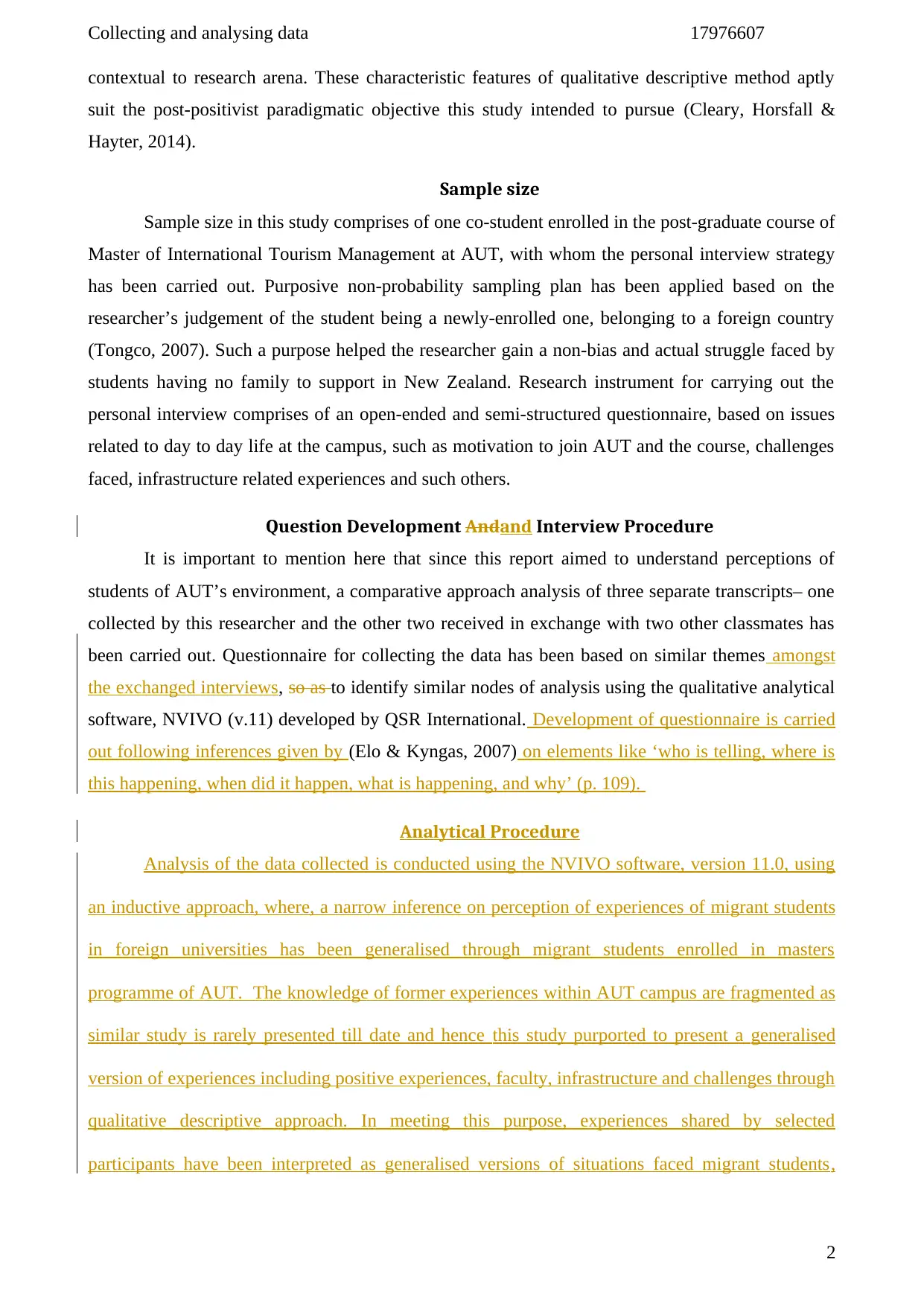
Collecting and analysing data 17976607
contextual to research arena. These characteristic features of qualitative descriptive method aptly
suit the post-positivist paradigmatic objective this study intended to pursue (Cleary, Horsfall &
Hayter, 2014).
Sample size
Sample size in this study comprises of one co-student enrolled in the post-graduate course of
Master of International Tourism Management at AUT, with whom the personal interview strategy
has been carried out. Purposive non-probability sampling plan has been applied based on the
researcher’s judgement of the student being a newly-enrolled one, belonging to a foreign country
(Tongco, 2007). Such a purpose helped the researcher gain a non-bias and actual struggle faced by
students having no family to support in New Zealand. Research instrument for carrying out the
personal interview comprises of an open-ended and semi-structured questionnaire, based on issues
related to day to day life at the campus, such as motivation to join AUT and the course, challenges
faced, infrastructure related experiences and such others.
Question Development Andand Interview Procedure
It is important to mention here that since this report aimed to understand perceptions of
students of AUT’s environment, a comparative approach analysis of three separate transcripts– one
collected by this researcher and the other two received in exchange with two other classmates has
been carried out. Questionnaire for collecting the data has been based on similar themes amongst
the exchanged interviews, so as to identify similar nodes of analysis using the qualitative analytical
software, NVIVO (v.11) developed by QSR International. Development of questionnaire is carried
out following inferences given by (Elo & Kyngas, 2007) on elements like ‘who is telling, where is
this happening, when did it happen, what is happening, and why’ (p. 109).
Analytical Procedure
Analysis of the data collected is conducted using the NVIVO software, version 11.0, using
an inductive approach, where, a narrow inference on perception of experiences of migrant students
in foreign universities has been generalised through migrant students enrolled in masters
programme of AUT. The knowledge of former experiences within AUT campus are fragmented as
similar study is rarely presented till date and hence this study purported to present a generalised
version of experiences including positive experiences, faculty, infrastructure and challenges through
qualitative descriptive approach. In meeting this purpose, experiences shared by selected
participants have been interpreted as generalised versions of situations faced migrant students,
2
contextual to research arena. These characteristic features of qualitative descriptive method aptly
suit the post-positivist paradigmatic objective this study intended to pursue (Cleary, Horsfall &
Hayter, 2014).
Sample size
Sample size in this study comprises of one co-student enrolled in the post-graduate course of
Master of International Tourism Management at AUT, with whom the personal interview strategy
has been carried out. Purposive non-probability sampling plan has been applied based on the
researcher’s judgement of the student being a newly-enrolled one, belonging to a foreign country
(Tongco, 2007). Such a purpose helped the researcher gain a non-bias and actual struggle faced by
students having no family to support in New Zealand. Research instrument for carrying out the
personal interview comprises of an open-ended and semi-structured questionnaire, based on issues
related to day to day life at the campus, such as motivation to join AUT and the course, challenges
faced, infrastructure related experiences and such others.
Question Development Andand Interview Procedure
It is important to mention here that since this report aimed to understand perceptions of
students of AUT’s environment, a comparative approach analysis of three separate transcripts– one
collected by this researcher and the other two received in exchange with two other classmates has
been carried out. Questionnaire for collecting the data has been based on similar themes amongst
the exchanged interviews, so as to identify similar nodes of analysis using the qualitative analytical
software, NVIVO (v.11) developed by QSR International. Development of questionnaire is carried
out following inferences given by (Elo & Kyngas, 2007) on elements like ‘who is telling, where is
this happening, when did it happen, what is happening, and why’ (p. 109).
Analytical Procedure
Analysis of the data collected is conducted using the NVIVO software, version 11.0, using
an inductive approach, where, a narrow inference on perception of experiences of migrant students
in foreign universities has been generalised through migrant students enrolled in masters
programme of AUT. The knowledge of former experiences within AUT campus are fragmented as
similar study is rarely presented till date and hence this study purported to present a generalised
version of experiences including positive experiences, faculty, infrastructure and challenges through
qualitative descriptive approach. In meeting this purpose, experiences shared by selected
participants have been interpreted as generalised versions of situations faced migrant students,
2
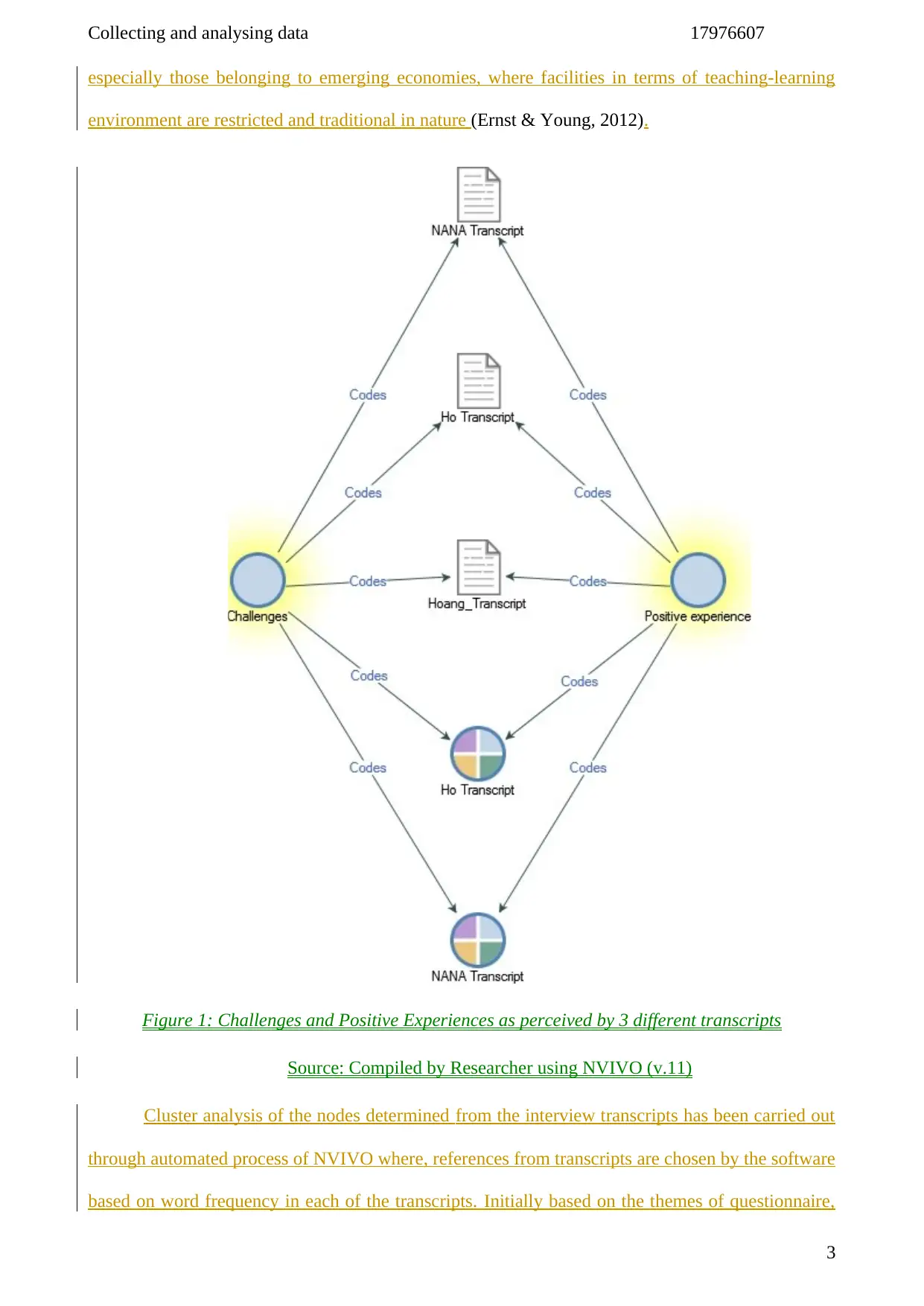
Collecting and analysing data 17976607
especially those belonging to emerging economies, where facilities in terms of teaching-learning
environment are restricted and traditional in nature (Ernst & Young, 2012).
Figure 1: Challenges and Positive Experiences as perceived by 3 different transcripts
Source: Compiled by Researcher using NVIVO (v.11)
Cluster analysis of the nodes determined from the interview transcripts has been carried out
through automated process of NVIVO where, references from transcripts are chosen by the software
based on word frequency in each of the transcripts. Initially based on the themes of questionnaire,
3
especially those belonging to emerging economies, where facilities in terms of teaching-learning
environment are restricted and traditional in nature (Ernst & Young, 2012).
Figure 1: Challenges and Positive Experiences as perceived by 3 different transcripts
Source: Compiled by Researcher using NVIVO (v.11)
Cluster analysis of the nodes determined from the interview transcripts has been carried out
through automated process of NVIVO where, references from transcripts are chosen by the software
based on word frequency in each of the transcripts. Initially based on the themes of questionnaire,
3
⊘ This is a preview!⊘
Do you want full access?
Subscribe today to unlock all pages.

Trusted by 1+ million students worldwide
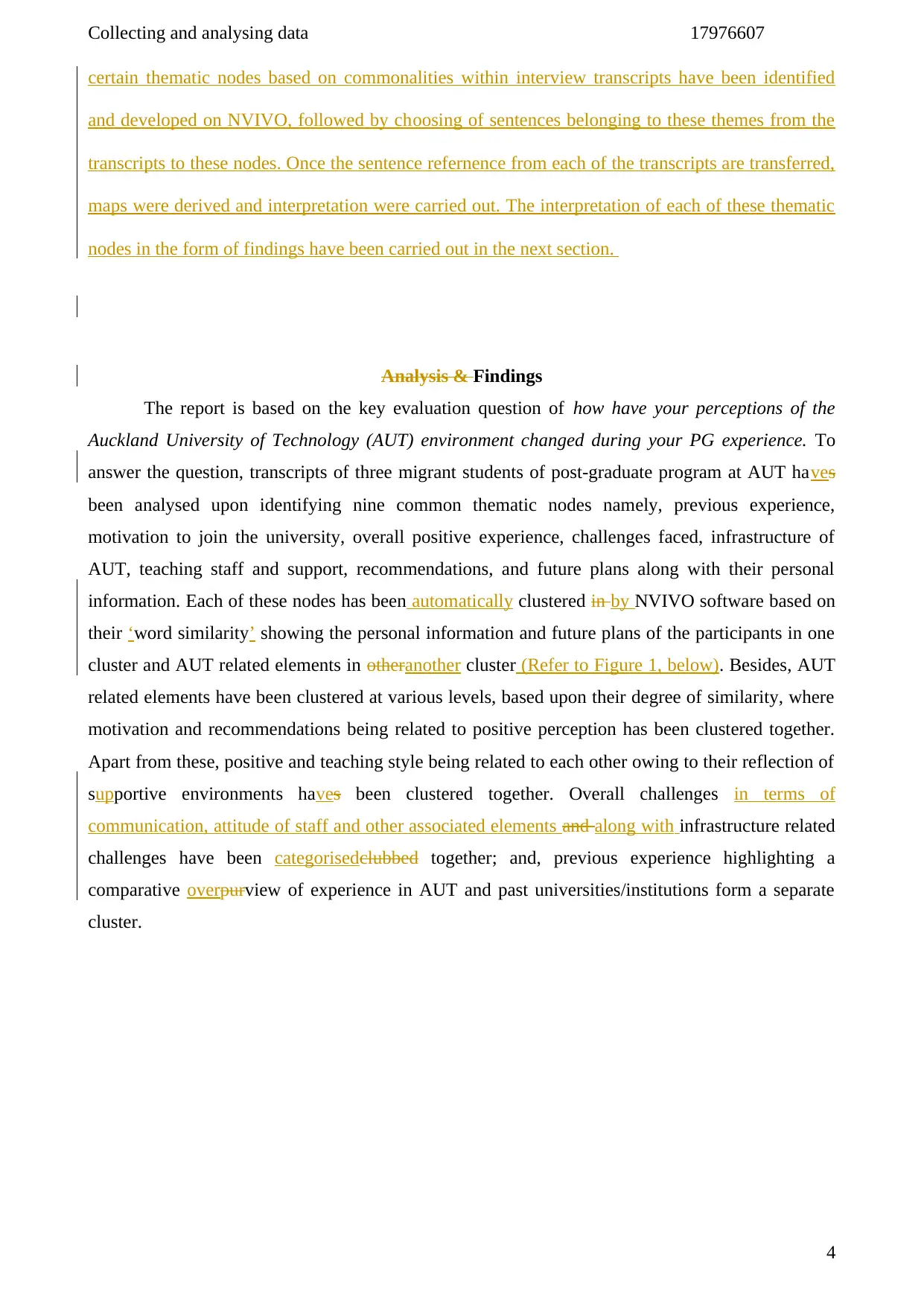
Collecting and analysing data 17976607
certain thematic nodes based on commonalities within interview transcripts have been identified
and developed on NVIVO, followed by choosing of sentences belonging to these themes from the
transcripts to these nodes. Once the sentence refernence from each of the transcripts are transferred,
maps were derived and interpretation were carried out. The interpretation of each of these thematic
nodes in the form of findings have been carried out in the next section.
Analysis & Findings
The report is based on the key evaluation question of how have your perceptions of the
Auckland University of Technology (AUT) environment changed during your PG experience. To
answer the question, transcripts of three migrant students of post-graduate program at AUT haves
been analysed upon identifying nine common thematic nodes namely, previous experience,
motivation to join the university, overall positive experience, challenges faced, infrastructure of
AUT, teaching staff and support, recommendations, and future plans along with their personal
information. Each of these nodes has been automatically clustered in by NVIVO software based on
their ‘word similarity’ showing the personal information and future plans of the participants in one
cluster and AUT related elements in otheranother cluster (Refer to Figure 1, below). Besides, AUT
related elements have been clustered at various levels, based upon their degree of similarity, where
motivation and recommendations being related to positive perception has been clustered together.
Apart from these, positive and teaching style being related to each other owing to their reflection of
supportive environments haves been clustered together. Overall challenges in terms of
communication, attitude of staff and other associated elements and along with infrastructure related
challenges have been categorisedclubbed together; and, previous experience highlighting a
comparative overpurview of experience in AUT and past universities/institutions form a separate
cluster.
4
certain thematic nodes based on commonalities within interview transcripts have been identified
and developed on NVIVO, followed by choosing of sentences belonging to these themes from the
transcripts to these nodes. Once the sentence refernence from each of the transcripts are transferred,
maps were derived and interpretation were carried out. The interpretation of each of these thematic
nodes in the form of findings have been carried out in the next section.
Analysis & Findings
The report is based on the key evaluation question of how have your perceptions of the
Auckland University of Technology (AUT) environment changed during your PG experience. To
answer the question, transcripts of three migrant students of post-graduate program at AUT haves
been analysed upon identifying nine common thematic nodes namely, previous experience,
motivation to join the university, overall positive experience, challenges faced, infrastructure of
AUT, teaching staff and support, recommendations, and future plans along with their personal
information. Each of these nodes has been automatically clustered in by NVIVO software based on
their ‘word similarity’ showing the personal information and future plans of the participants in one
cluster and AUT related elements in otheranother cluster (Refer to Figure 1, below). Besides, AUT
related elements have been clustered at various levels, based upon their degree of similarity, where
motivation and recommendations being related to positive perception has been clustered together.
Apart from these, positive and teaching style being related to each other owing to their reflection of
supportive environments haves been clustered together. Overall challenges in terms of
communication, attitude of staff and other associated elements and along with infrastructure related
challenges have been categorisedclubbed together; and, previous experience highlighting a
comparative overpurview of experience in AUT and past universities/institutions form a separate
cluster.
4
Paraphrase This Document
Need a fresh take? Get an instant paraphrase of this document with our AI Paraphraser
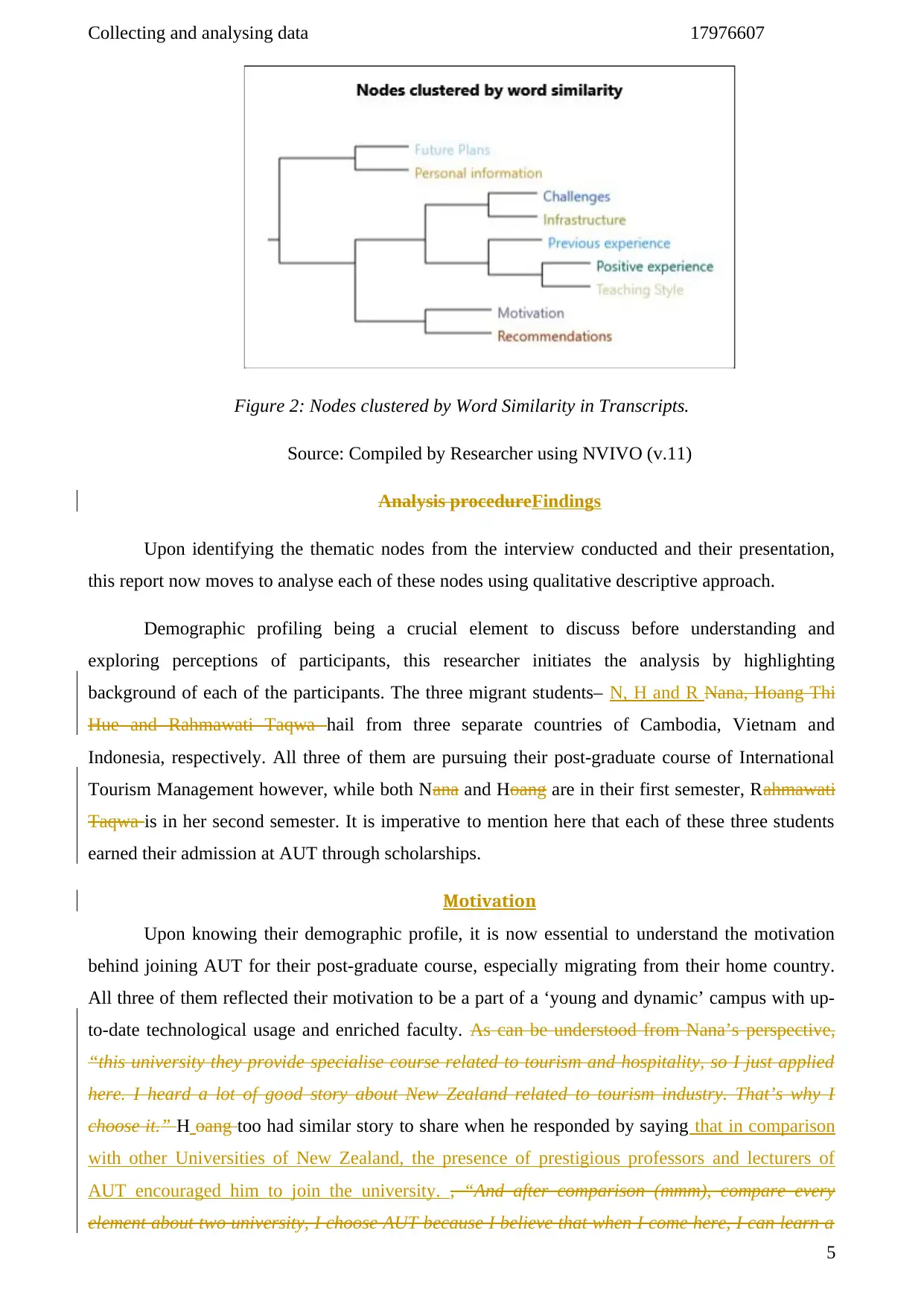
Collecting and analysing data 17976607
Figure 2: Nodes clustered by Word Similarity in Transcripts.
Source: Compiled by Researcher using NVIVO (v.11)
Analysis procedureFindings
Upon identifying the thematic nodes from the interview conducted and their presentation,
this report now moves to analyse each of these nodes using qualitative descriptive approach.
Demographic profiling being a crucial element to discuss before understanding and
exploring perceptions of participants, this researcher initiates the analysis by highlighting
background of each of the participants. The three migrant students– N, H and R Nana, Hoang Thi
Hue and Rahmawati Taqwa hail from three separate countries of Cambodia, Vietnam and
Indonesia, respectively. All three of them are pursuing their post-graduate course of International
Tourism Management however, while both Nana and Hoang are in their first semester, Rahmawati
Taqwa is in her second semester. It is imperative to mention here that each of these three students
earned their admission at AUT through scholarships.
Motivation
Upon knowing their demographic profile, it is now essential to understand the motivation
behind joining AUT for their post-graduate course, especially migrating from their home country.
All three of them reflected their motivation to be a part of a ‘young and dynamic’ campus with up-
to-date technological usage and enriched faculty. As can be understood from Nana’s perspective,
“this university they provide specialise course related to tourism and hospitality, so I just applied
here. I heard a lot of good story about New Zealand related to tourism industry. That’s why I
choose it.” H oang too had similar story to share when he responded by saying that in comparison
with other Universities of New Zealand, the presence of prestigious professors and lecturers of
AUT encouraged him to join the university. , “And after comparison (mmm), compare every
element about two university, I choose AUT because I believe that when I come here, I can learn a
5
Figure 2: Nodes clustered by Word Similarity in Transcripts.
Source: Compiled by Researcher using NVIVO (v.11)
Analysis procedureFindings
Upon identifying the thematic nodes from the interview conducted and their presentation,
this report now moves to analyse each of these nodes using qualitative descriptive approach.
Demographic profiling being a crucial element to discuss before understanding and
exploring perceptions of participants, this researcher initiates the analysis by highlighting
background of each of the participants. The three migrant students– N, H and R Nana, Hoang Thi
Hue and Rahmawati Taqwa hail from three separate countries of Cambodia, Vietnam and
Indonesia, respectively. All three of them are pursuing their post-graduate course of International
Tourism Management however, while both Nana and Hoang are in their first semester, Rahmawati
Taqwa is in her second semester. It is imperative to mention here that each of these three students
earned their admission at AUT through scholarships.
Motivation
Upon knowing their demographic profile, it is now essential to understand the motivation
behind joining AUT for their post-graduate course, especially migrating from their home country.
All three of them reflected their motivation to be a part of a ‘young and dynamic’ campus with up-
to-date technological usage and enriched faculty. As can be understood from Nana’s perspective,
“this university they provide specialise course related to tourism and hospitality, so I just applied
here. I heard a lot of good story about New Zealand related to tourism industry. That’s why I
choose it.” H oang too had similar story to share when he responded by saying that in comparison
with other Universities of New Zealand, the presence of prestigious professors and lecturers of
AUT encouraged him to join the university. , “And after comparison (mmm), compare every
element about two university, I choose AUT because I believe that when I come here, I can learn a
5
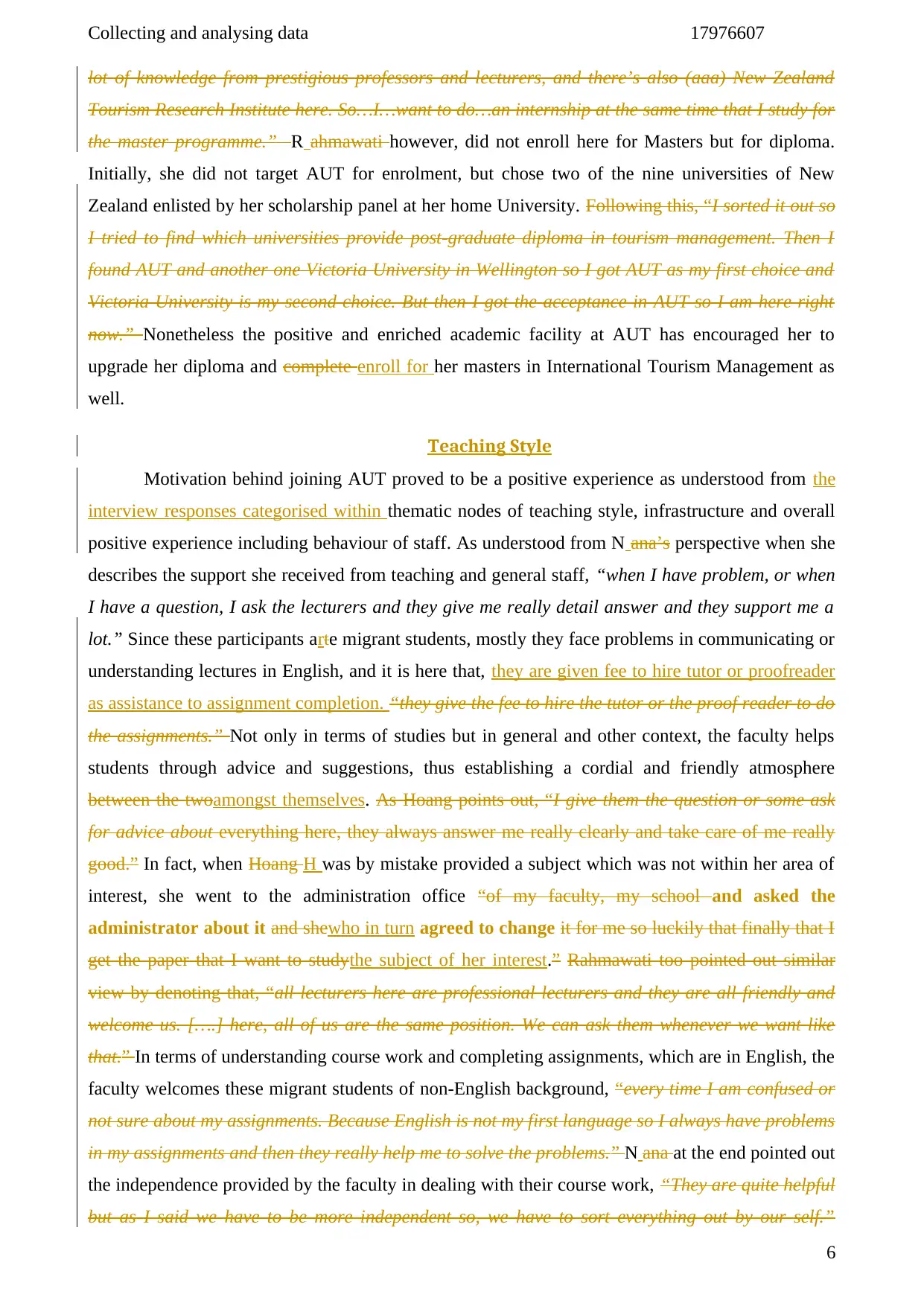
Collecting and analysing data 17976607
lot of knowledge from prestigious professors and lecturers, and there’s also (aaa) New Zealand
Tourism Research Institute here. So…I…want to do…an internship at the same time that I study for
the master programme.” R ahmawati however, did not enroll here for Masters but for diploma.
Initially, she did not target AUT for enrolment, but chose two of the nine universities of New
Zealand enlisted by her scholarship panel at her home University. Following this, “I sorted it out so
I tried to find which universities provide post-graduate diploma in tourism management. Then I
found AUT and another one Victoria University in Wellington so I got AUT as my first choice and
Victoria University is my second choice. But then I got the acceptance in AUT so I am here right
now.” Nonetheless the positive and enriched academic facility at AUT has encouraged her to
upgrade her diploma and complete enroll for her masters in International Tourism Management as
well.
Teaching Style
Motivation behind joining AUT proved to be a positive experience as understood from the
interview responses categorised within thematic nodes of teaching style, infrastructure and overall
positive experience including behaviour of staff. As understood from N ana’s perspective when she
describes the support she received from teaching and general staff, “when I have problem, or when
I have a question, I ask the lecturers and they give me really detail answer and they support me a
lot.” Since these participants arte migrant students, mostly they face problems in communicating or
understanding lectures in English, and it is here that, they are given fee to hire tutor or proofreader
as assistance to assignment completion. “they give the fee to hire the tutor or the proof reader to do
the assignments.” Not only in terms of studies but in general and other context, the faculty helps
students through advice and suggestions, thus establishing a cordial and friendly atmosphere
between the twoamongst themselves. As Hoang points out, “I give them the question or some ask
for advice about everything here, they always answer me really clearly and take care of me really
good.” In fact, when Hoang H was by mistake provided a subject which was not within her area of
interest, she went to the administration office “of my faculty, my school and asked the
administrator about it and shewho in turn agreed to change it for me so luckily that finally that I
get the paper that I want to studythe subject of her interest.” Rahmawati too pointed out similar
view by denoting that, “all lecturers here are professional lecturers and they are all friendly and
welcome us. [….] here, all of us are the same position. We can ask them whenever we want like
that.” In terms of understanding course work and completing assignments, which are in English, the
faculty welcomes these migrant students of non-English background, “every time I am confused or
not sure about my assignments. Because English is not my first language so I always have problems
in my assignments and then they really help me to solve the problems.” N ana at the end pointed out
the independence provided by the faculty in dealing with their course work, “They are quite helpful
but as I said we have to be more independent so, we have to sort everything out by our self.”
6
lot of knowledge from prestigious professors and lecturers, and there’s also (aaa) New Zealand
Tourism Research Institute here. So…I…want to do…an internship at the same time that I study for
the master programme.” R ahmawati however, did not enroll here for Masters but for diploma.
Initially, she did not target AUT for enrolment, but chose two of the nine universities of New
Zealand enlisted by her scholarship panel at her home University. Following this, “I sorted it out so
I tried to find which universities provide post-graduate diploma in tourism management. Then I
found AUT and another one Victoria University in Wellington so I got AUT as my first choice and
Victoria University is my second choice. But then I got the acceptance in AUT so I am here right
now.” Nonetheless the positive and enriched academic facility at AUT has encouraged her to
upgrade her diploma and complete enroll for her masters in International Tourism Management as
well.
Teaching Style
Motivation behind joining AUT proved to be a positive experience as understood from the
interview responses categorised within thematic nodes of teaching style, infrastructure and overall
positive experience including behaviour of staff. As understood from N ana’s perspective when she
describes the support she received from teaching and general staff, “when I have problem, or when
I have a question, I ask the lecturers and they give me really detail answer and they support me a
lot.” Since these participants arte migrant students, mostly they face problems in communicating or
understanding lectures in English, and it is here that, they are given fee to hire tutor or proofreader
as assistance to assignment completion. “they give the fee to hire the tutor or the proof reader to do
the assignments.” Not only in terms of studies but in general and other context, the faculty helps
students through advice and suggestions, thus establishing a cordial and friendly atmosphere
between the twoamongst themselves. As Hoang points out, “I give them the question or some ask
for advice about everything here, they always answer me really clearly and take care of me really
good.” In fact, when Hoang H was by mistake provided a subject which was not within her area of
interest, she went to the administration office “of my faculty, my school and asked the
administrator about it and shewho in turn agreed to change it for me so luckily that finally that I
get the paper that I want to studythe subject of her interest.” Rahmawati too pointed out similar
view by denoting that, “all lecturers here are professional lecturers and they are all friendly and
welcome us. [….] here, all of us are the same position. We can ask them whenever we want like
that.” In terms of understanding course work and completing assignments, which are in English, the
faculty welcomes these migrant students of non-English background, “every time I am confused or
not sure about my assignments. Because English is not my first language so I always have problems
in my assignments and then they really help me to solve the problems.” N ana at the end pointed out
the independence provided by the faculty in dealing with their course work, “They are quite helpful
but as I said we have to be more independent so, we have to sort everything out by our self.”
6
⊘ This is a preview!⊘
Do you want full access?
Subscribe today to unlock all pages.

Trusted by 1+ million students worldwide
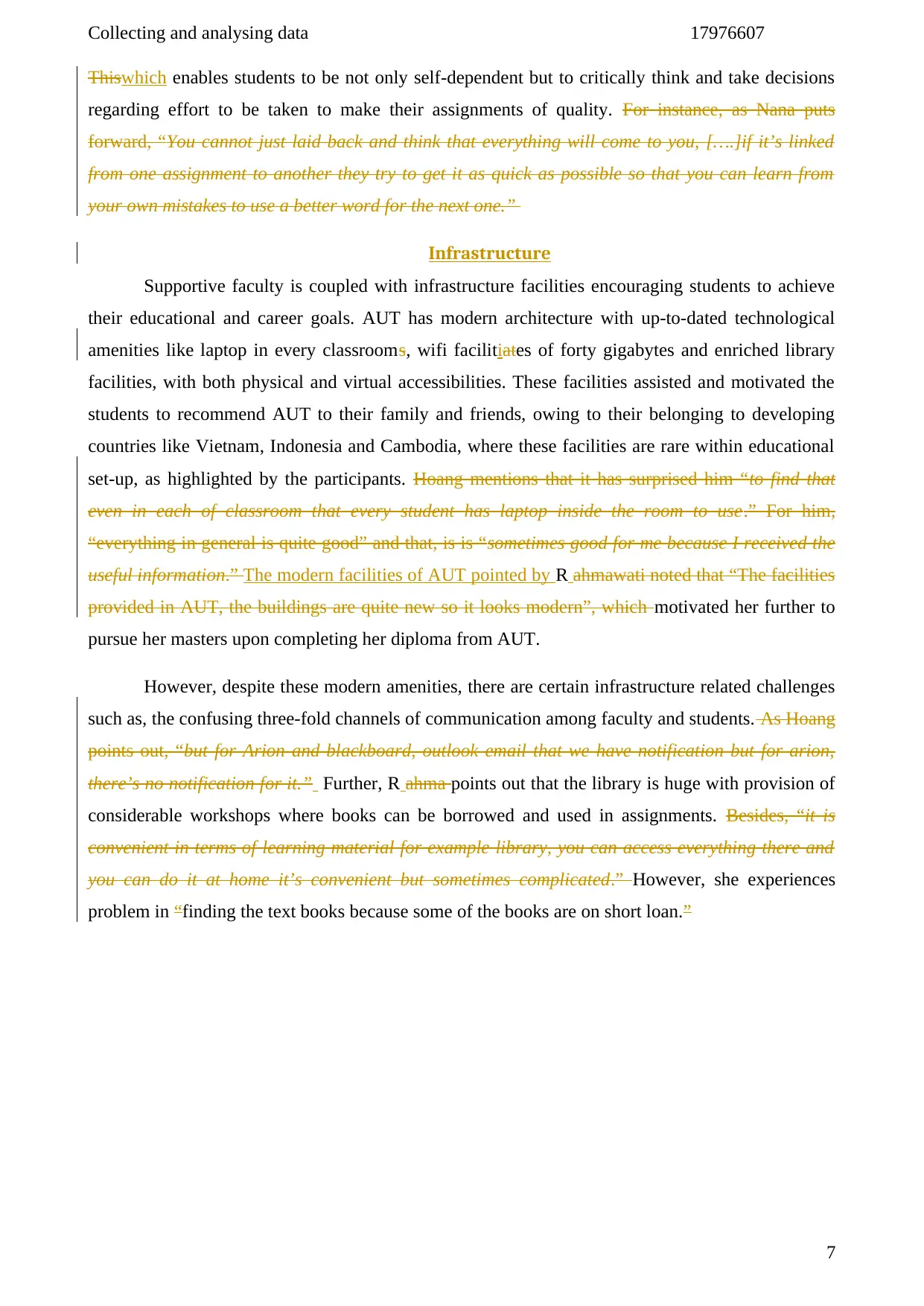
Collecting and analysing data 17976607
Thiswhich enables students to be not only self-dependent but to critically think and take decisions
regarding effort to be taken to make their assignments of quality. For instance, as Nana puts
forward, “You cannot just laid back and think that everything will come to you, [….]if it’s linked
from one assignment to another they try to get it as quick as possible so that you can learn from
your own mistakes to use a better word for the next one.”
Infrastructure
Supportive faculty is coupled with infrastructure facilities encouraging students to achieve
their educational and career goals. AUT has modern architecture with up-to-dated technological
amenities like laptop in every classrooms, wifi facilitiates of forty gigabytes and enriched library
facilities, with both physical and virtual accessibilities. These facilities assisted and motivated the
students to recommend AUT to their family and friends, owing to their belonging to developing
countries like Vietnam, Indonesia and Cambodia, where these facilities are rare within educational
set-up, as highlighted by the participants. Hoang mentions that it has surprised him “to find that
even in each of classroom that every student has laptop inside the room to use.” For him,
“everything in general is quite good” and that, is is “sometimes good for me because I received the
useful information.” The modern facilities of AUT pointed by R ahmawati noted that “The facilities
provided in AUT, the buildings are quite new so it looks modern”, which motivated her further to
pursue her masters upon completing her diploma from AUT.
However, despite these modern amenities, there are certain infrastructure related challenges
such as, the confusing three-fold channels of communication among faculty and students. As Hoang
points out, “but for Arion and blackboard, outlook email that we have notification but for arion,
there’s no notification for it.” Further, R ahma points out that the library is huge with provision of
considerable workshops where books can be borrowed and used in assignments. Besides, “it is
convenient in terms of learning material for example library, you can access everything there and
you can do it at home it’s convenient but sometimes complicated.” However, she experiences
problem in “finding the text books because some of the books are on short loan.”
7
Thiswhich enables students to be not only self-dependent but to critically think and take decisions
regarding effort to be taken to make their assignments of quality. For instance, as Nana puts
forward, “You cannot just laid back and think that everything will come to you, [….]if it’s linked
from one assignment to another they try to get it as quick as possible so that you can learn from
your own mistakes to use a better word for the next one.”
Infrastructure
Supportive faculty is coupled with infrastructure facilities encouraging students to achieve
their educational and career goals. AUT has modern architecture with up-to-dated technological
amenities like laptop in every classrooms, wifi facilitiates of forty gigabytes and enriched library
facilities, with both physical and virtual accessibilities. These facilities assisted and motivated the
students to recommend AUT to their family and friends, owing to their belonging to developing
countries like Vietnam, Indonesia and Cambodia, where these facilities are rare within educational
set-up, as highlighted by the participants. Hoang mentions that it has surprised him “to find that
even in each of classroom that every student has laptop inside the room to use.” For him,
“everything in general is quite good” and that, is is “sometimes good for me because I received the
useful information.” The modern facilities of AUT pointed by R ahmawati noted that “The facilities
provided in AUT, the buildings are quite new so it looks modern”, which motivated her further to
pursue her masters upon completing her diploma from AUT.
However, despite these modern amenities, there are certain infrastructure related challenges
such as, the confusing three-fold channels of communication among faculty and students. As Hoang
points out, “but for Arion and blackboard, outlook email that we have notification but for arion,
there’s no notification for it.” Further, R ahma points out that the library is huge with provision of
considerable workshops where books can be borrowed and used in assignments. Besides, “it is
convenient in terms of learning material for example library, you can access everything there and
you can do it at home it’s convenient but sometimes complicated.” However, she experiences
problem in “finding the text books because some of the books are on short loan.”
7
Paraphrase This Document
Need a fresh take? Get an instant paraphrase of this document with our AI Paraphraser
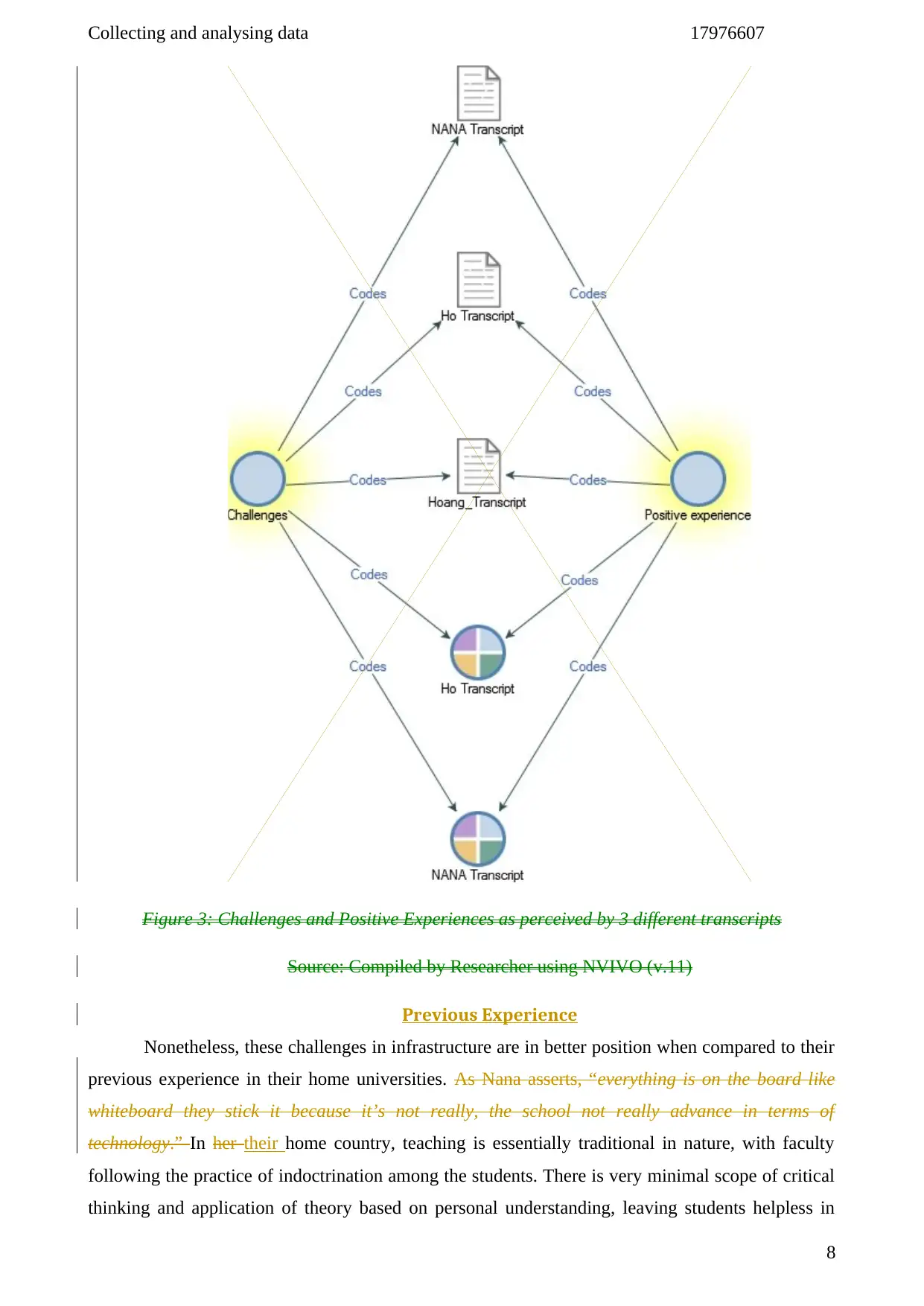
Collecting and analysing data 17976607
Figure 3: Challenges and Positive Experiences as perceived by 3 different transcripts
Source: Compiled by Researcher using NVIVO (v.11)
Previous Experience
Nonetheless, these challenges in infrastructure are in better position when compared to their
previous experience in their home universities. As Nana asserts, “everything is on the board like
whiteboard they stick it because it’s not really, the school not really advance in terms of
technology.” In her their home country, teaching is essentially traditional in nature, with faculty
following the practice of indoctrination among the students. There is very minimal scope of critical
thinking and application of theory based on personal understanding, leaving students helpless in
8
Figure 3: Challenges and Positive Experiences as perceived by 3 different transcripts
Source: Compiled by Researcher using NVIVO (v.11)
Previous Experience
Nonetheless, these challenges in infrastructure are in better position when compared to their
previous experience in their home universities. As Nana asserts, “everything is on the board like
whiteboard they stick it because it’s not really, the school not really advance in terms of
technology.” In her their home country, teaching is essentially traditional in nature, with faculty
following the practice of indoctrination among the students. There is very minimal scope of critical
thinking and application of theory based on personal understanding, leaving students helpless in
8
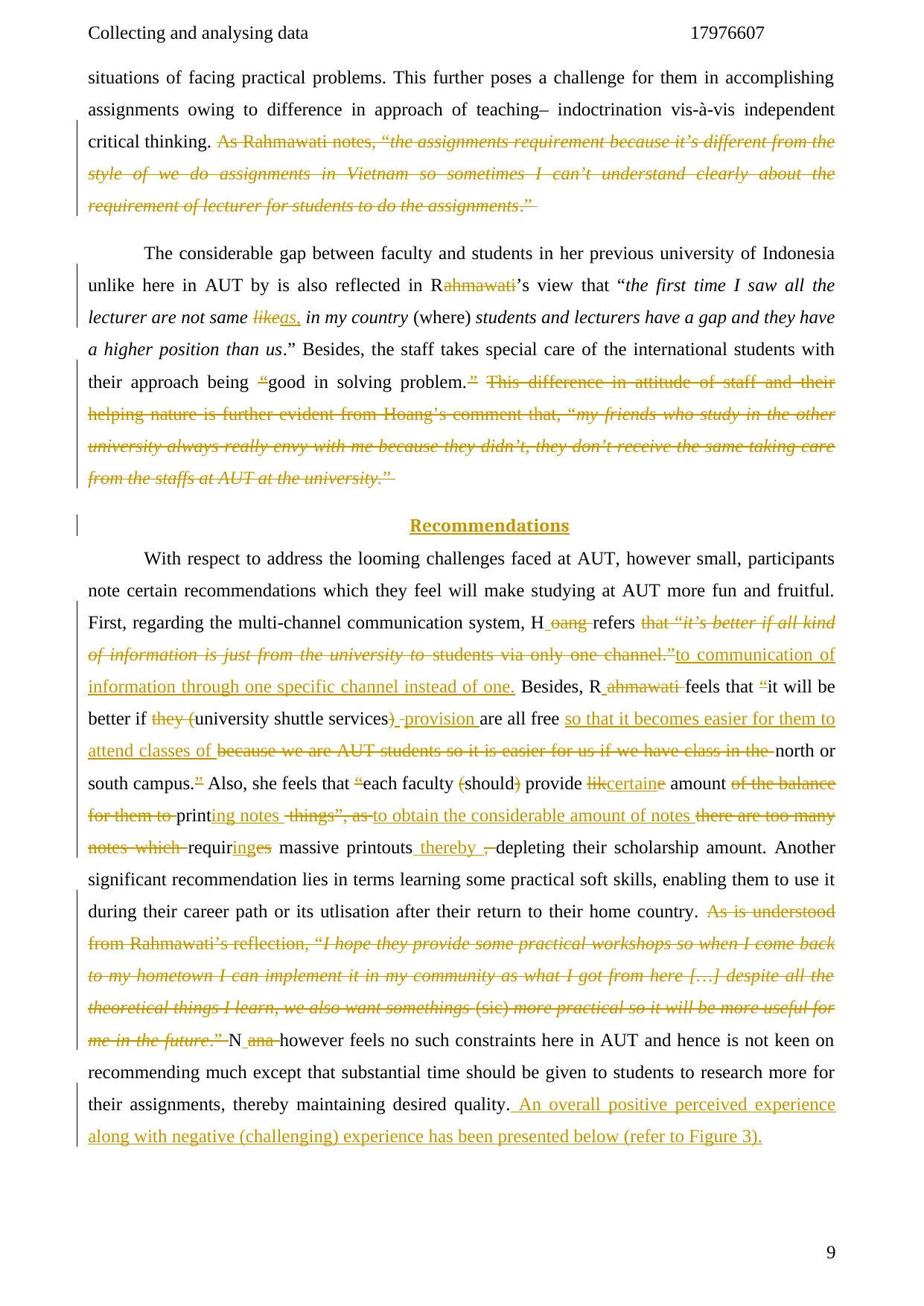
Collecting and analysing data 17976607
situations of facing practical problems. This further poses a challenge for them in accomplishing
assignments owing to difference in approach of teaching– indoctrination vis-à-vis independent
critical thinking. As Rahmawati notes, “the assignments requirement because it’s different from the
style of we do assignments in Vietnam so sometimes I can’t understand clearly about the
requirement of lecturer for students to do the assignments.”
The considerable gap between faculty and students in her previous university of Indonesia
unlike here in AUT by is also reflected in Rahmawati’s view that “the first time I saw all the
lecturer are not same likeas, in my country (where) students and lecturers have a gap and they have
a higher position than us.” Besides, the staff takes special care of the international students with
their approach being “good in solving problem.” This difference in attitude of staff and their
helping nature is further evident from Hoang’s comment that, “my friends who study in the other
university always really envy with me because they didn’t, they don’t receive the same taking care
from the staffs at AUT at the university.”
Recommendations
With respect to address the looming challenges faced at AUT, however small, participants
note certain recommendations which they feel will make studying at AUT more fun and fruitful.
First, regarding the multi-channel communication system, H oang refers that “it’s better if all kind
of information is just from the university to students via only one channel.”to communication of
information through one specific channel instead of one. Besides, R ahmawati feels that “it will be
better if they (university shuttle services) provision are all free so that it becomes easier for them to
attend classes of because we are AUT students so it is easier for us if we have class in the north or
south campus.” Also, she feels that “each faculty (should) provide likcertaine amount of the balance
for them to printing notes things”, as to obtain the considerable amount of notes there are too many
notes which requiringes massive printouts thereby , depleting their scholarship amount. Another
significant recommendation lies in terms learning some practical soft skills, enabling them to use it
during their career path or its utlisation after their return to their home country. As is understood
from Rahmawati’s reflection, “I hope they provide some practical workshops so when I come back
to my hometown I can implement it in my community as what I got from here […] despite all the
theoretical things I learn, we also want somethings (sic) more practical so it will be more useful for
me in the future.” N ana however feels no such constraints here in AUT and hence is not keen on
recommending much except that substantial time should be given to students to research more for
their assignments, thereby maintaining desired quality. An overall positive perceived experience
along with negative (challenging) experience has been presented below (refer to Figure 3).
9
situations of facing practical problems. This further poses a challenge for them in accomplishing
assignments owing to difference in approach of teaching– indoctrination vis-à-vis independent
critical thinking. As Rahmawati notes, “the assignments requirement because it’s different from the
style of we do assignments in Vietnam so sometimes I can’t understand clearly about the
requirement of lecturer for students to do the assignments.”
The considerable gap between faculty and students in her previous university of Indonesia
unlike here in AUT by is also reflected in Rahmawati’s view that “the first time I saw all the
lecturer are not same likeas, in my country (where) students and lecturers have a gap and they have
a higher position than us.” Besides, the staff takes special care of the international students with
their approach being “good in solving problem.” This difference in attitude of staff and their
helping nature is further evident from Hoang’s comment that, “my friends who study in the other
university always really envy with me because they didn’t, they don’t receive the same taking care
from the staffs at AUT at the university.”
Recommendations
With respect to address the looming challenges faced at AUT, however small, participants
note certain recommendations which they feel will make studying at AUT more fun and fruitful.
First, regarding the multi-channel communication system, H oang refers that “it’s better if all kind
of information is just from the university to students via only one channel.”to communication of
information through one specific channel instead of one. Besides, R ahmawati feels that “it will be
better if they (university shuttle services) provision are all free so that it becomes easier for them to
attend classes of because we are AUT students so it is easier for us if we have class in the north or
south campus.” Also, she feels that “each faculty (should) provide likcertaine amount of the balance
for them to printing notes things”, as to obtain the considerable amount of notes there are too many
notes which requiringes massive printouts thereby , depleting their scholarship amount. Another
significant recommendation lies in terms learning some practical soft skills, enabling them to use it
during their career path or its utlisation after their return to their home country. As is understood
from Rahmawati’s reflection, “I hope they provide some practical workshops so when I come back
to my hometown I can implement it in my community as what I got from here […] despite all the
theoretical things I learn, we also want somethings (sic) more practical so it will be more useful for
me in the future.” N ana however feels no such constraints here in AUT and hence is not keen on
recommending much except that substantial time should be given to students to research more for
their assignments, thereby maintaining desired quality. An overall positive perceived experience
along with negative (challenging) experience has been presented below (refer to Figure 3).
9
⊘ This is a preview!⊘
Do you want full access?
Subscribe today to unlock all pages.

Trusted by 1+ million students worldwide
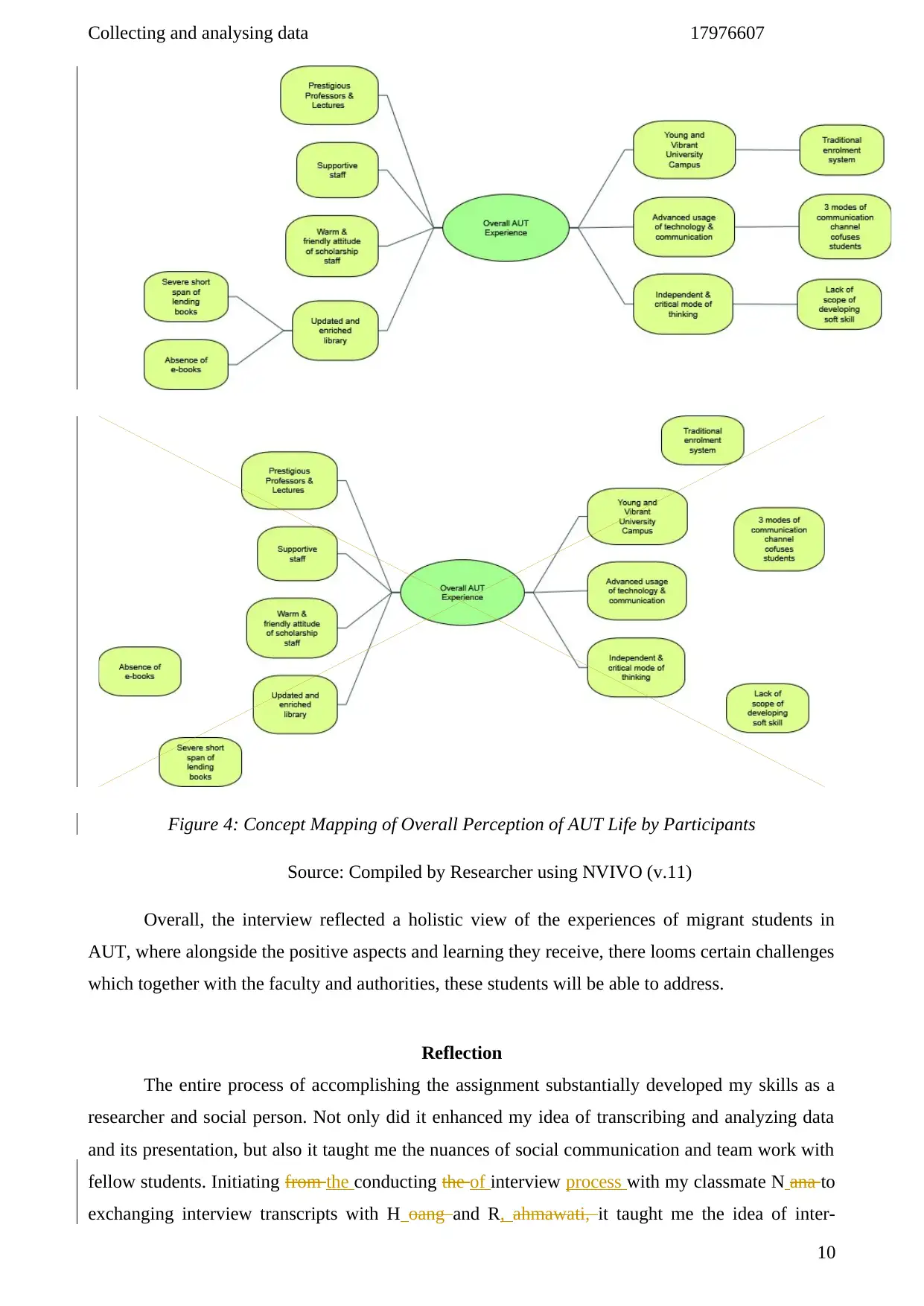
Collecting and analysing data 17976607
Figure 4: Concept Mapping of Overall Perception of AUT Life by Participants
Source: Compiled by Researcher using NVIVO (v.11)
Overall, the interview reflected a holistic view of the experiences of migrant students in
AUT, where alongside the positive aspects and learning they receive, there looms certain challenges
which together with the faculty and authorities, these students will be able to address.
Reflection
The entire process of accomplishing the assignment substantially developed my skills as a
researcher and social person. Not only did it enhanced my idea of transcribing and analyzing data
and its presentation, but also it taught me the nuances of social communication and team work with
fellow students. Initiating from the conducting the of interview process with my classmate N ana to
exchanging interview transcripts with H oang and R, ahmawati, it taught me the idea of inter-
10
Figure 4: Concept Mapping of Overall Perception of AUT Life by Participants
Source: Compiled by Researcher using NVIVO (v.11)
Overall, the interview reflected a holistic view of the experiences of migrant students in
AUT, where alongside the positive aspects and learning they receive, there looms certain challenges
which together with the faculty and authorities, these students will be able to address.
Reflection
The entire process of accomplishing the assignment substantially developed my skills as a
researcher and social person. Not only did it enhanced my idea of transcribing and analyzing data
and its presentation, but also it taught me the nuances of social communication and team work with
fellow students. Initiating from the conducting the of interview process with my classmate N ana to
exchanging interview transcripts with H oang and R, ahmawati, it taught me the idea of inter-
10
Paraphrase This Document
Need a fresh take? Get an instant paraphrase of this document with our AI Paraphraser
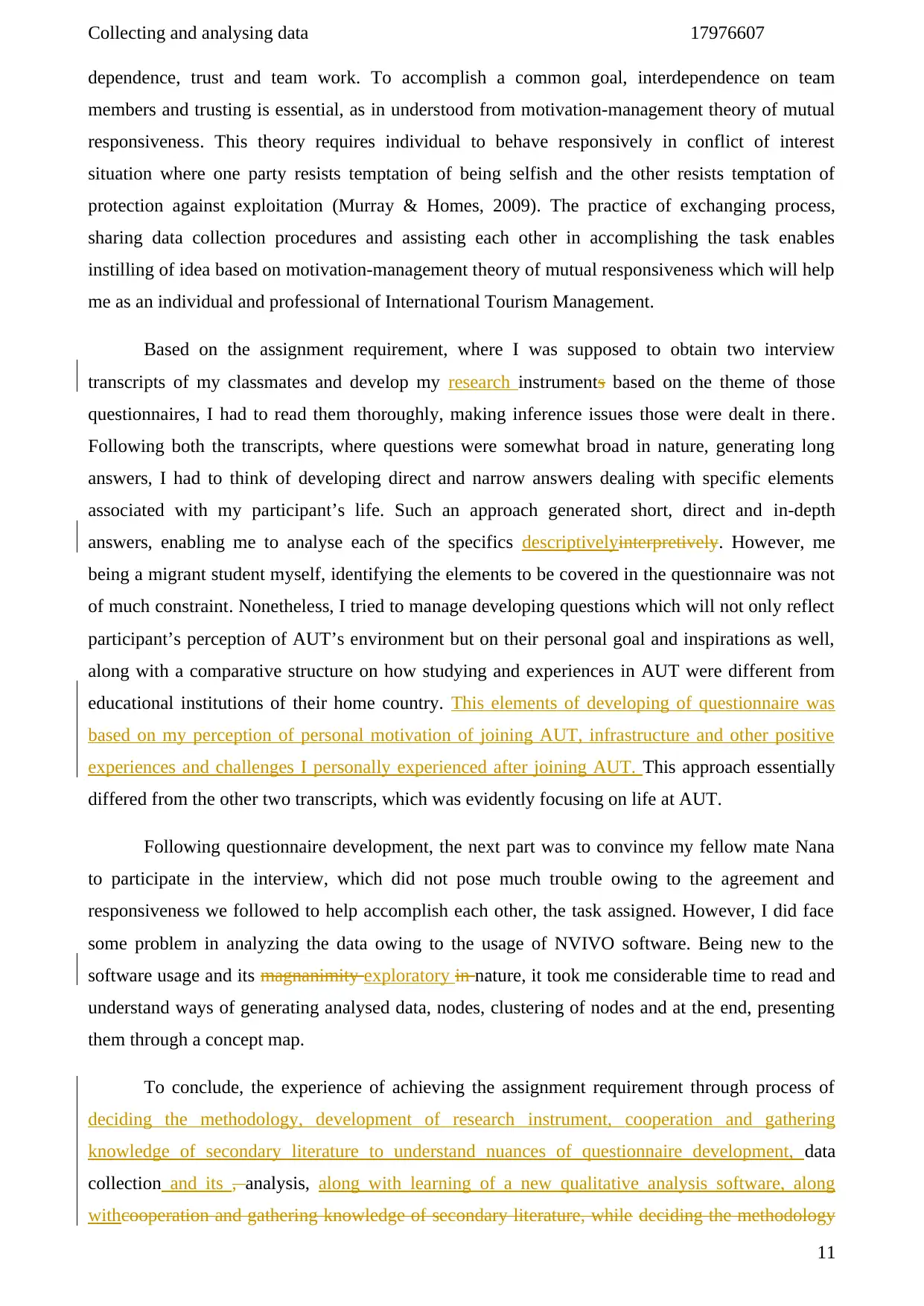
Collecting and analysing data 17976607
dependence, trust and team work. To accomplish a common goal, interdependence on team
members and trusting is essential, as in understood from motivation-management theory of mutual
responsiveness. This theory requires individual to behave responsively in conflict of interest
situation where one party resists temptation of being selfish and the other resists temptation of
protection against exploitation (Murray & Homes, 2009). The practice of exchanging process,
sharing data collection procedures and assisting each other in accomplishing the task enables
instilling of idea based on motivation-management theory of mutual responsiveness which will help
me as an individual and professional of International Tourism Management.
Based on the assignment requirement, where I was supposed to obtain two interview
transcripts of my classmates and develop my research instruments based on the theme of those
questionnaires, I had to read them thoroughly, making inference issues those were dealt in there.
Following both the transcripts, where questions were somewhat broad in nature, generating long
answers, I had to think of developing direct and narrow answers dealing with specific elements
associated with my participant’s life. Such an approach generated short, direct and in-depth
answers, enabling me to analyse each of the specifics descriptivelyinterpretively. However, me
being a migrant student myself, identifying the elements to be covered in the questionnaire was not
of much constraint. Nonetheless, I tried to manage developing questions which will not only reflect
participant’s perception of AUT’s environment but on their personal goal and inspirations as well,
along with a comparative structure on how studying and experiences in AUT were different from
educational institutions of their home country. This elements of developing of questionnaire was
based on my perception of personal motivation of joining AUT, infrastructure and other positive
experiences and challenges I personally experienced after joining AUT. This approach essentially
differed from the other two transcripts, which was evidently focusing on life at AUT.
Following questionnaire development, the next part was to convince my fellow mate Nana
to participate in the interview, which did not pose much trouble owing to the agreement and
responsiveness we followed to help accomplish each other, the task assigned. However, I did face
some problem in analyzing the data owing to the usage of NVIVO software. Being new to the
software usage and its magnanimity exploratory in nature, it took me considerable time to read and
understand ways of generating analysed data, nodes, clustering of nodes and at the end, presenting
them through a concept map.
To conclude, the experience of achieving the assignment requirement through process of
deciding the methodology, development of research instrument, cooperation and gathering
knowledge of secondary literature to understand nuances of questionnaire development, data
collection and its , analysis, along with learning of a new qualitative analysis software, along
withcooperation and gathering knowledge of secondary literature, while deciding the methodology
11
dependence, trust and team work. To accomplish a common goal, interdependence on team
members and trusting is essential, as in understood from motivation-management theory of mutual
responsiveness. This theory requires individual to behave responsively in conflict of interest
situation where one party resists temptation of being selfish and the other resists temptation of
protection against exploitation (Murray & Homes, 2009). The practice of exchanging process,
sharing data collection procedures and assisting each other in accomplishing the task enables
instilling of idea based on motivation-management theory of mutual responsiveness which will help
me as an individual and professional of International Tourism Management.
Based on the assignment requirement, where I was supposed to obtain two interview
transcripts of my classmates and develop my research instruments based on the theme of those
questionnaires, I had to read them thoroughly, making inference issues those were dealt in there.
Following both the transcripts, where questions were somewhat broad in nature, generating long
answers, I had to think of developing direct and narrow answers dealing with specific elements
associated with my participant’s life. Such an approach generated short, direct and in-depth
answers, enabling me to analyse each of the specifics descriptivelyinterpretively. However, me
being a migrant student myself, identifying the elements to be covered in the questionnaire was not
of much constraint. Nonetheless, I tried to manage developing questions which will not only reflect
participant’s perception of AUT’s environment but on their personal goal and inspirations as well,
along with a comparative structure on how studying and experiences in AUT were different from
educational institutions of their home country. This elements of developing of questionnaire was
based on my perception of personal motivation of joining AUT, infrastructure and other positive
experiences and challenges I personally experienced after joining AUT. This approach essentially
differed from the other two transcripts, which was evidently focusing on life at AUT.
Following questionnaire development, the next part was to convince my fellow mate Nana
to participate in the interview, which did not pose much trouble owing to the agreement and
responsiveness we followed to help accomplish each other, the task assigned. However, I did face
some problem in analyzing the data owing to the usage of NVIVO software. Being new to the
software usage and its magnanimity exploratory in nature, it took me considerable time to read and
understand ways of generating analysed data, nodes, clustering of nodes and at the end, presenting
them through a concept map.
To conclude, the experience of achieving the assignment requirement through process of
deciding the methodology, development of research instrument, cooperation and gathering
knowledge of secondary literature to understand nuances of questionnaire development, data
collection and its , analysis, along with learning of a new qualitative analysis software, along
withcooperation and gathering knowledge of secondary literature, while deciding the methodology
11
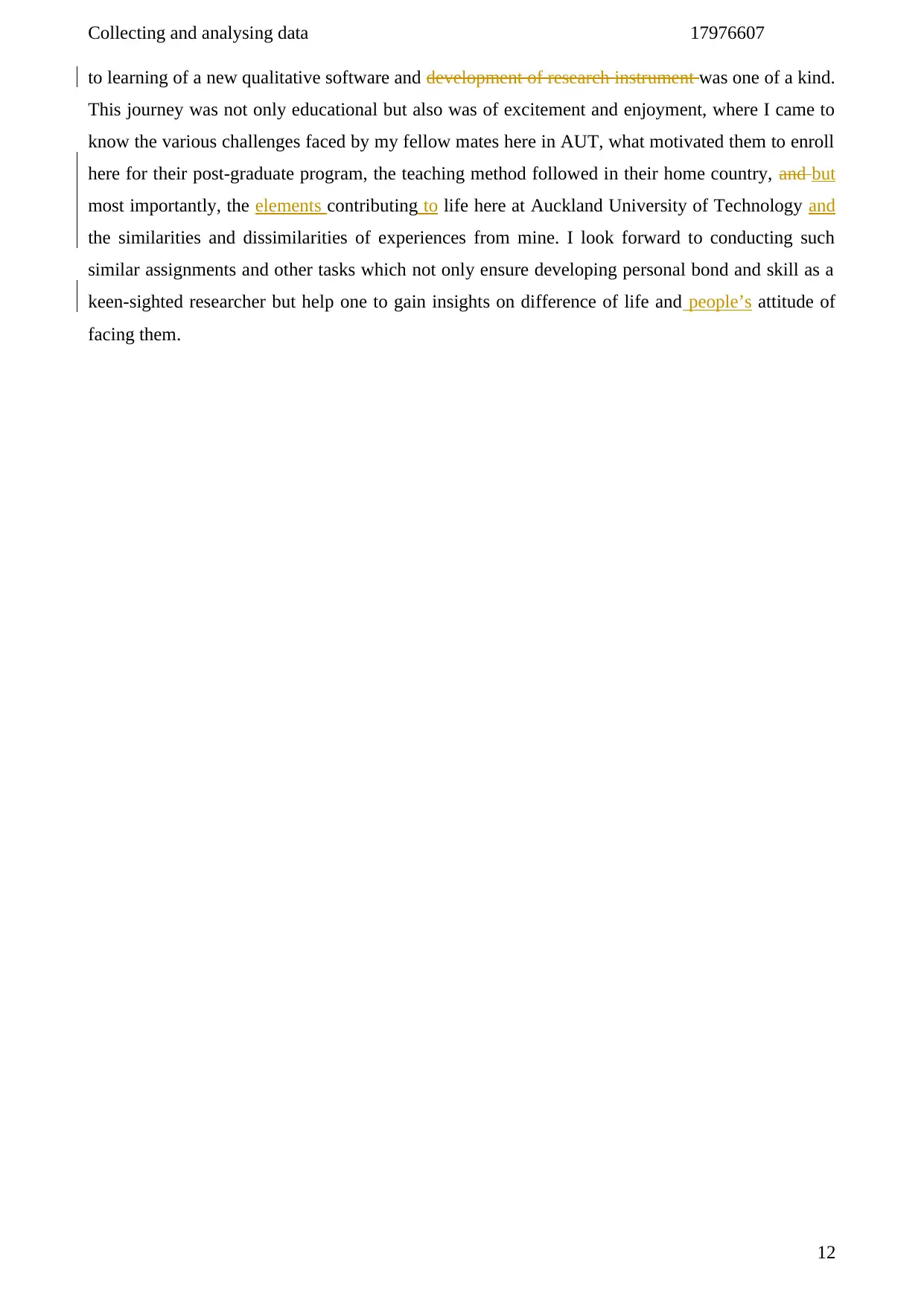
Collecting and analysing data 17976607
to learning of a new qualitative software and development of research instrument was one of a kind.
This journey was not only educational but also was of excitement and enjoyment, where I came to
know the various challenges faced by my fellow mates here in AUT, what motivated them to enroll
here for their post-graduate program, the teaching method followed in their home country, and but
most importantly, the elements contributing to life here at Auckland University of Technology and
the similarities and dissimilarities of experiences from mine. I look forward to conducting such
similar assignments and other tasks which not only ensure developing personal bond and skill as a
keen-sighted researcher but help one to gain insights on difference of life and people’s attitude of
facing them.
12
to learning of a new qualitative software and development of research instrument was one of a kind.
This journey was not only educational but also was of excitement and enjoyment, where I came to
know the various challenges faced by my fellow mates here in AUT, what motivated them to enroll
here for their post-graduate program, the teaching method followed in their home country, and but
most importantly, the elements contributing to life here at Auckland University of Technology and
the similarities and dissimilarities of experiences from mine. I look forward to conducting such
similar assignments and other tasks which not only ensure developing personal bond and skill as a
keen-sighted researcher but help one to gain insights on difference of life and people’s attitude of
facing them.
12
⊘ This is a preview!⊘
Do you want full access?
Subscribe today to unlock all pages.

Trusted by 1+ million students worldwide
1 out of 68
Related Documents
Your All-in-One AI-Powered Toolkit for Academic Success.
+13062052269
info@desklib.com
Available 24*7 on WhatsApp / Email
![[object Object]](/_next/static/media/star-bottom.7253800d.svg)
Unlock your academic potential
Copyright © 2020–2025 A2Z Services. All Rights Reserved. Developed and managed by ZUCOL.





